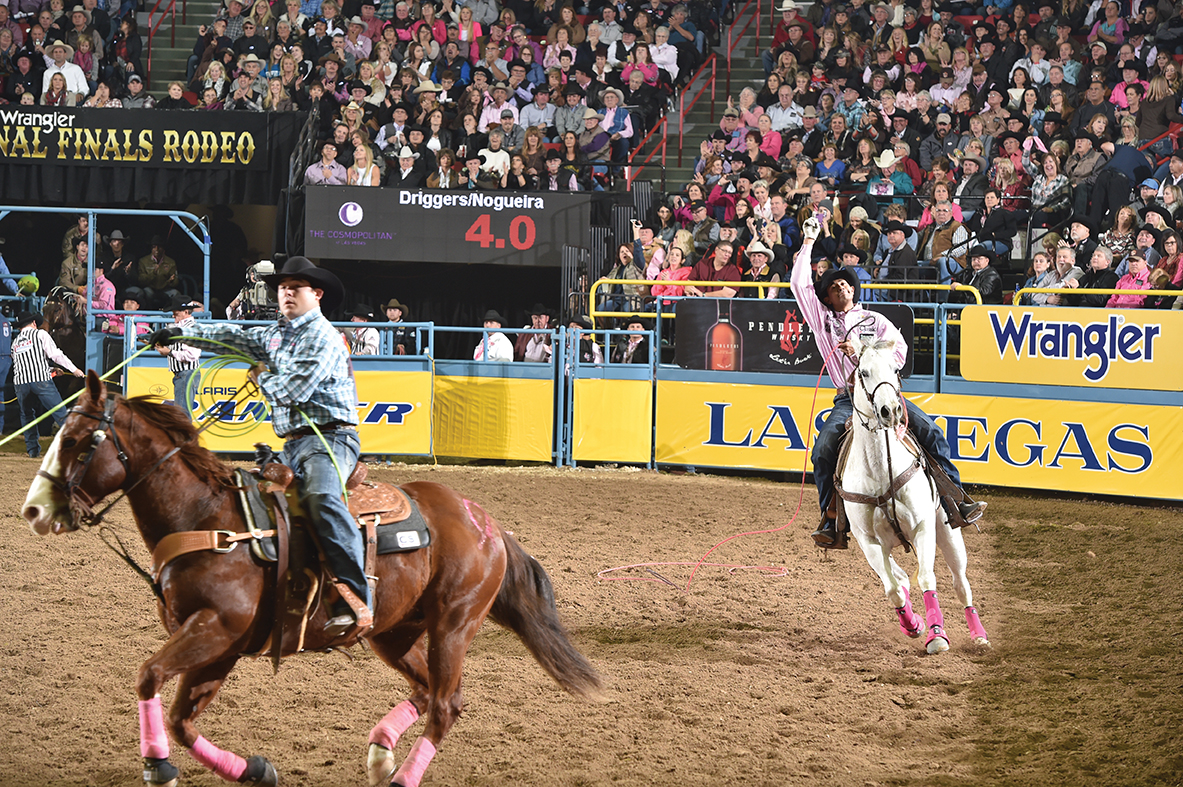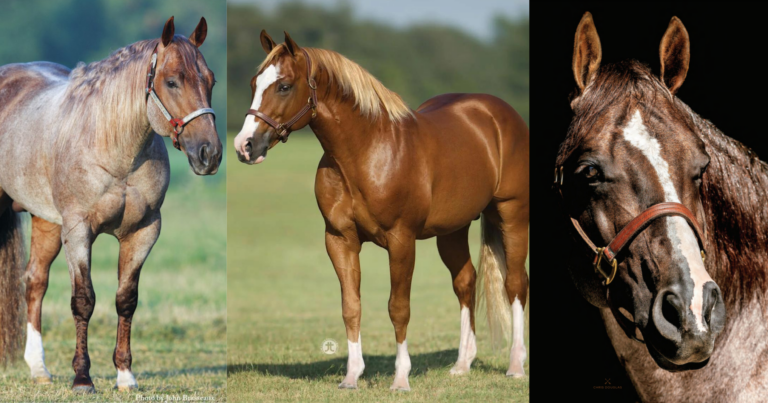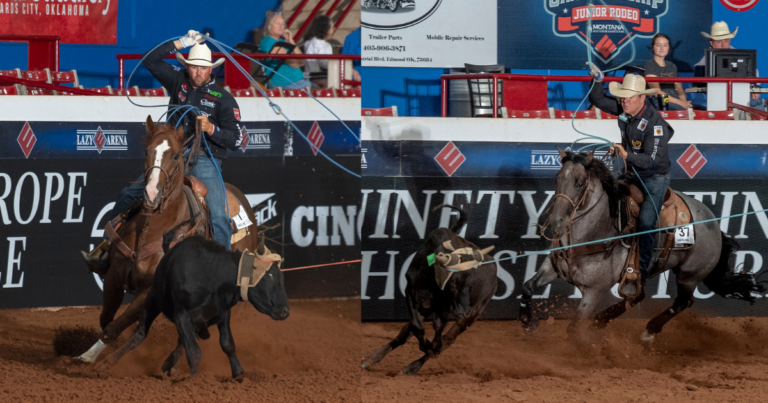Junior Nogueira’s Apache R Hali has long been one of the richest mares in team roping with over $500,000 in rodeo and Open jackpot earnings. Now, she’s ready to be one of the richest mamas, too.
There have been so many amazing working moms in the rope-horse world over the years. And when you get to ride a great one, like, say, Junior Nogueira’s Hali, Dustin Bird’s Dolly or Cody Snow’s Annie, why wouldn’t you want a rerun? It’s a long haul—and maybe even a long shot—for history to repeat itself when your hopeful expectation is greatness. But modern veterinary medicine makes it not only possible, but a bet with odds more ropers find worth taking all the time.
A big, stout gray mare by the name of Apache R Hali is reigning World Champion Heeler Junior Nogueira’s all-time favorite horse.
“When you have a great mare, she will try harder than a gelding or a stud,” Junior said. “Not all of them, but the special ones, like Hali, they give you everything they have every single time.
“Hali is my favorite horse ever, because she tries so hard and gives you the same trip every time. She’s the same horse on her best and worst days, and she’s always honest. It’s hard to expect that out of anybody—horse or human. Hali’s like an automatic car. It doesn’t matter what the steer does, she’s there and makes it happen.”
With career earnings of more than $600,000, including what Nogueira and Kollin VonAhn won on her before him, Hali’s in rare company among rodeo rope horses. And in 2020, she and Junior took it to the top of the horse show world with the American Quarter Horse Association Senior Heading World Championship and Reserve Senior Heeling World Championship (they finished just half a point away from the golden globe on the heeling side, too).
“You see horse show horses transition into rodeo horses,” Junior said. “But for a rodeo horse like Hali, who’s been a rodeo horse since she was 4 or 5, to go to the World Show and do that is unheard of. That’s something you don’t see, and she did it in heading and heeling. I’m so proud of her in the arena. And now I’m so proud of her as a momma. Hali’s babies are just unreal. They’re unbelievably good.”
There are four Hali babies in the world, with another on the way. The first two are fillies—one by Shining Spark, the other by Hickory Holly Time. Junior sold Hali’s first two babies, and they live in Brazil now. The two he kept are 2, and include a stud colt by Slick By Design, and a filly by Hashtags.
“They kind of look like the studs, but both move exactly like Hali,” Junior said. “They have beautiful heads and hips. I’m so excited to ride them.”
Hali’s 16 now, and Junior has Timon and Lucky Bucky out there on the rodeo road these days. So it was pretty easy to give her some maternity leave.
“Hali was a little older when she became a mom, so I gave her some time off,” he said. “I still ride her some at home and at a few jackpots, but now when I ride Hali it’s mostly to remind me what I want from all my other horses.”
The good news for all you ropers out there wanting to replicate greatness is that motherhood doesn’t have to mean leaving home without them. There’s no greater expert on equine reproduction in the world today than Dr. Gregg VeneKlasen, who works out of his Timber Creek Veterinary Hospital in Canyon, Texas.
“I have the greatest mares on earth here right now,” said VeneKlasen, who’s been in the mare-breeding business for 41 years and was last year honored as the 2022 Professional Rodeo Cowboys Association Veterinarian of the Year. “They’re elite cutting horses, working cow horses, barrel horses and lots of bucking horses. There are a lot of talented mares in rodeo right now, including Mabel in the steer wrestling. One of the first ropers to bring mares here was actually Trevor Brazile. Those babies are 6 years old now, and are great horses.”

With all the resources available today, VeneKlasen says there’s no reason performance-horse mares need to sit at home for reproduction purposes.
“They don’t need to be sidelined at all,” he said. “You can get a mare palpated to see where she’s at in her cycle and bred on the road with shipped semen. It’s not very hard to do, and you can breed a mare today and rope on her today. In a perfect world, you ought to be able to get an embryo within six weeks. And it only takes about 25 minutes to flush an embryo out of a mare and place it into a recip mare.”
There are several scenarios here for performance-horse mares. There’s the traveling “pit stops” option, using multiple veterinarians along your route. Other people rehab mares who get hurt at a facility like Timber Creek, and get an embryo out of them during their recovery time. But as with most things in life, timing is everything.
“Everybody wants a January baby, so you basically have three months to get this done with a fresh embryo or seven months to do it frozen,” VeneKlasen said. “If you flush an embryo in the summertime, you need to freeze it. The average gestation period for horses is 11 months and a week. So the perfect date to put an embryo in a mare to get a January 1st baby is the first or second week of February.”
The process is relatively simple, and the cost of getting all of this done is surprisingly reasonable.
“Having $5,000 into each embryo, including leasing the recip mare for a year, is industry standard these days,” VeneKlasen said. “And as far as how often this can happen, if in a perfect world you get four embryos out of one mare in a year, you’re doing great.”
Junior says he’ll be happy if Hali’s babies come anywhere close to her caliber.
“If they are half the horses Hali is, they will be great,” he said. “We need great horses to win, and I’ve been blessed with amazing horses my whole career. So when you have a special horse like Hali, you have to try for a next generation. Her genetics are special, and mares are the key to great horses. Studs make good horses. But the best horses have great moms.”











